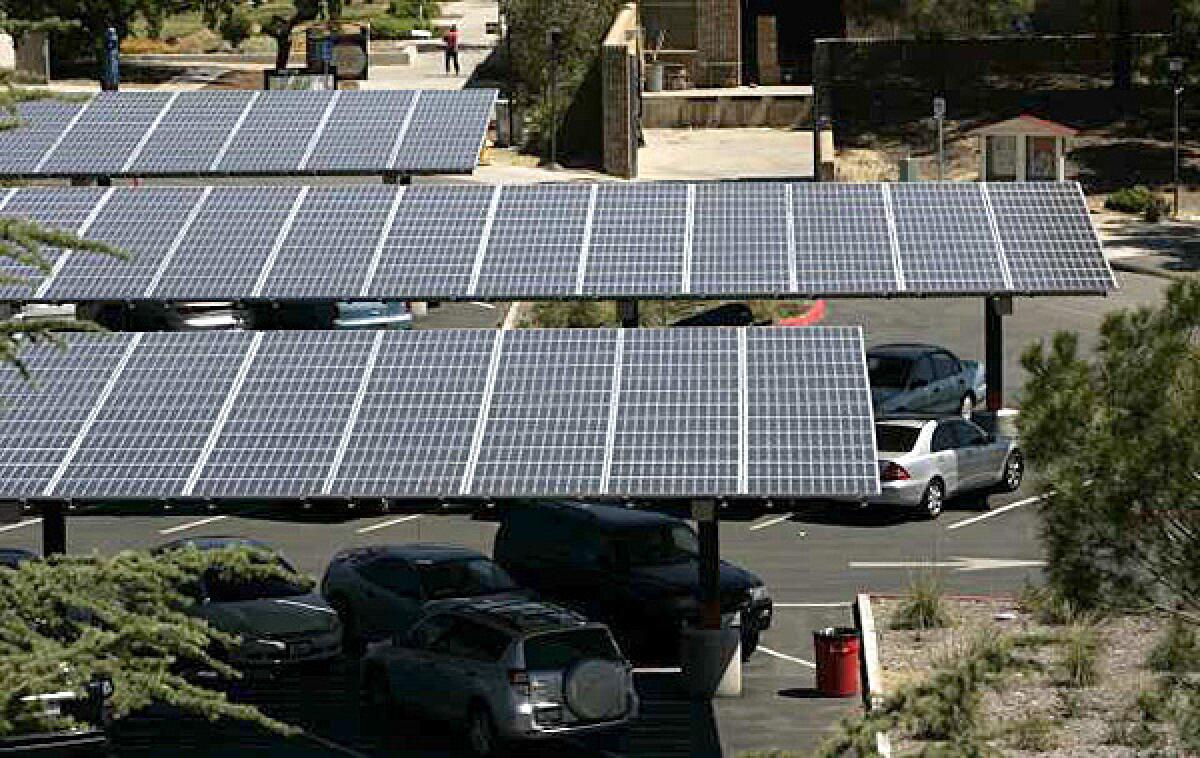Grand dream loses sheen in glare of daylight

- Share via
Larry Eisenberg had a vision. “Amazing,” he called it. “Spectacular.”
The Los Angeles Community College District would become a paragon of clean energy. By generating solar, wind and geothermal power, the district would supply all its electricity needs. Not only would the nine colleges sever ties to the grid, saving millions of dollars a year, they would make money by selling surplus power. Thanks to state and federal subsidies, construction of the green energy projects would cost nothing upfront.
Billions to Spend: Complete Coverage
As head of a $5.7-billion, taxpayer-funded program to rebuild the college campuses, Eisenberg commanded attention. But his plan for energy independence was seriously flawed.
He overestimated how much power the colleges could generate. He underestimated the cost. And he poured millions of dollars into designs for projects that proved so impractical or unpopular they were never built.
These and other blunders cost nearly $10 million that could have paid for new classrooms, laboratories and other college facilities, a Times investigation found.
The problems with Eisenberg’s energy vision were fundamental. For starters, there simply wasn’t room on the campuses for all the generating equipment required to become self-sufficient. Some of the colleges wouldn’t come close to that goal even if solar panels, wind turbines and other devices were wedged into every available space.
Going off the grid did not make economic sense either. Given the cost of alternative energy technology, it would be more expensive for the district to generate all its own electricity than to continue paying utilities for power.
Weather and geology also refused to cooperate.
Three solar power arrays had to be scrapped because the intended locations were atop seismic faults.
Plans for large-scale wind power collided with the reality that prevailing winds at nearly all the campuses are too weak to generate much electricity. To date, a single wind turbine has been installed, as a demonstration project. It spins too slowly in average winds to power a 60-watt light bulb.
In the end, Eisenberg’s grand plan was scaled down to what was actually doable, which was a fraction of the green energy capacity he had envisioned.
By then, the district had committed at least $4 million to designs for solar and wind energy farms that would never get beyond blueprints.
As one project after another was scratched, an elaborate plan to pay for it all with money from private investors fell apart. But the investment banks that put the deals together had to be paid for their work. The cost: $2.8 million.
At Southwest College, the district spent an additional $1.2 million on a parking lot shaded by solar panels, only to abandon the project with the work half done.
At Valley College, one of the solar arrays that was actually built sat idle for 14 months, thanks to a dispute between a contractor and the district over who was supposed to arrange a hookup to the power grid. The delay cost $1.5 million in potential energy savings, according to the college.
Eisenberg, the district’s executive director of facilities planning and development, conceded some mistakes but voiced no regrets. He cast himself as an environmental visionary and predicted that the college system would eventually achieve energy independence. “Somebody needs to be first,” he said. “If the great explorers really had a map and knew where they were going, maybe we wouldn’t have the result we have today.”
Unyielding enthusiasm
Eisenberg, now 59, grew up in Sun Valley, the son of a TV repairman and a secretary for the probation department. He was student body president of North Hollywood High School and became the first member of his family to attend college. He earned a bachelor’s degree in urban studies at the Massachusetts Institute of Technology and a master’s in public affairs at the University of Texas at Austin.
After a succession of jobs managing public buildings in Wisconsin, Eisenberg was hired in 1993 as facilities chief for Washington County, Ore., which encompasses suburbs of Portland.
In 1995, he and his wife, Christine, filed for personal bankruptcy, listing assets of $236,000 and liabilities of $262,000. Most of the debt, aside from their home loan, was to credit-card companies; they also owed $21,000 in back taxes. The bankruptcy case was closed after the couple completed a payment plan in 1999.
Eisenberg ran into difficulties at his job as well.
His boss, Bob Davis, “wanted to get rid of Larry because of mismanagement,” Washington County Commissioner Andy Duyck said in an interview. Duyck said he did not know the reason for Davis’ displeasure, and Davis, the county administrator, declined to comment.
Eisenberg recalled that Davis “let me know he was unhappy” with his job performance. He depicted it as a clash of management styles: Davis’ was conservative, while his own was creative and entrepreneurial, Eisenberg said.
“I’m not risk-averse,” Eisenberg said. “In retrospect, maybe they think they should have gotten rid of me sooner.”
Eisenberg left the Oregon job in August 2003 to become head of facilities and new construction for the Los Angeles college district. He acknowledged that he had not told district officials about his bankruptcy. He said it had no bearing on his professional life.
Eisenberg was put in charge of the campus construction program, one of California’s largest public works projects.
A mandate from the district’s Board of Trustees to incorporate renewable power into new buildings offered him a chance to make his name as a leader in green construction.
He was tireless in promoting the program’s eco-friendly aspects, traveling at taxpayer expense to Zurich, Switzerland, to speak at a conference of the International Sustainable Campus Network. He made similar presentations in New Orleans, Seattle and Atlanta.
His advocacy had a messianic tinge. In one e-mail to his advisors, he described his renewable-energy agenda as “what the world needs now. No one else is doing it. We can and will.”
The trustees encouraged Eisenberg’s push for green energy, even as his plan grew steadily more ambitious. They liked the idea of freeing the colleges from dependence on fossil fuels and were content to leave the practical details to him.
But Eisenberg’s enthusiasm obscured an inconvenient reality: With the technology now available, the cost of renewable power exceeds that of energy derived from burning coal and natural gas.
Green energy advocates often argue that the added cost is justified by the reduction in pollution, particularly carbon emissions that contribute to global warming.
Eisenberg talked up the environmental benefits of his plan. But he also insisted that it would cost less than continuing to rely on conventional sources of electricity. Private investors, he explained, would put up almost all the money in order to take advantage of tax breaks, and they would pass the savings on to the district.
In the end, he said, government subsidies would reduce the district’s purchase and installation costs as much as 90%.
One thing was for sure: No matter how it was financed, the bill for all those solar panels and wind turbines would be huge. Eisenberg’s cost estimates for taking the nine campuses off the grid ranged as high as $975 million — this for a college system that in 2010 spent less than $8 million on power bills.
An engineering consultant put the cost far higher: $1.9 billion. That number caught the attention of Marshall Drummond, then chancellor of the college district. It was enough to pay for several dozen new classroom buildings. In December 2008, the chancellor summoned Eisenberg and his energy team to explain.
Drummond was unimpressed by what he heard. In an e-mail to college presidents, he complained about “missing components and what may be shaky assumptions.” He called Eisenberg’s plan “an unvalidated ‘dream.’”
Drummond welcomed Eisenberg’s push for solar power and his efforts to maximize energy efficiency in new buildings.
What concerned him were what he called “Martian technologies.”
Eisenberg wanted to spend $98 million on hydrogen fuel-cell equipment that had never been put into commercial operation. He called for spending $59 million on untried hydrogen storage devices and $78 million on batteries. The idea was to stock up on solar power during the day and use it at night, a concept experts see as too costly to be viable with current technology.
Eisenberg also proposed $78 million in geothermal and wind projects — even though local weather patterns had led his own technical advisors to conclude that these plans made no sense.
In regions prone to extremes of hot and cold, pumping water through pipes hundreds of feet underground to heat or cool buildings with geothermal energy can produce big savings. But in Southern California’s temperate climate, a geothermal system would not work well and the savings were unlikely to justify the cost, the advisors said.
Eisenberg’s enthusiasm for wind energy also outran the facts. Among the projects he touted was the Windjet, a windmill that could be built in various sizes, including one as big as a Ferris wheel.
Its creator, a Manhattan Beach inventor named Brad Sorenson, called the Windjet the “highest efficiency wind power system in history.” It existed only in miniature prototype, run in part with a bicycle chain. Sorensen hauled the contraption around in the trunk of his car.
Eisenberg wanted to put one on each of the nine campuses.
A district energy advisor, Andrew Hoffman, dismissed the Windjet as a fantasy, telling Eisenberg that Sorensen “claims he can extract more power from the wind than is theoretically possible.
“When dealing with issues on the human scale, the laws of Newtonian physics are non-negotiable,” Hoffman wrote.
Undeterred, Eisenberg asked Sorensen how soon he could produce a Windjet for each college. “We need to proceed immediately with purchase and installation,” Eisenberg told the inventor in an e-mail.
Nothing came of the proposal.
“I don’t think it’s really ready for the world,” Sorensen said in an interview.
Costly designs ordered
In his zeal to start building, Eisenberg failed to fill in the details of his grand vision or line up necessary support within the district. Yet in 2008, he started ordering costly designs for solar projects.
The nine college presidents hold veto power over all campus construction, and in their view, every dollar spent on green power was a dollar not spent on new buildings.
They agreed to some solar installations but spiked others they saw as too expensive or unsightly.
For Valley College, Eisenberg’s team produced maps showing fields of solar panels covering nearly half the campus. Trees would be chopped down. Lawns would be covered with photovoltaic panels.
The college rejected the plan.
“If we wanted to look like a power station, we would have called ourselves Valley College Power Station,” said Don Gauthier, president of the college’s Academic Senate.
For West Los Angeles College, Eisenberg solicited a dazzling design. He called on John Musick, a Brentwood entrepreneur who bills himself as the ideal consultant when “your IPO is DOA and your MBA and legal beagles are numb,” to produce a “high level concept picture” of solar projects for the Culver City campus.
In May 2009, Musick proposed a giant elevated platform of energy devices. Reflective panels and other machinery would spread across 25 acres of open space and rise as high as 100 feet.
“Imagine the robust solar and wind and bio fuel efficiencies we will employ combined with the massive astonishing architectural statement at the new entrance to WLA,” Musick wrote Eisenberg. “It will be pleasingly visible from far away, much like the Getty Center. A fitting credit to the leadership of LACCD.”
Tony Fairclough, an engineer who is the district’s technical director for renewable power, told Eisenberg there was “nothing substantive” to back up Musick’s claim that his solar panels could produce energy with “record efficiency” — 50 megawatts in all, many times what the campus would ever need.
About the same time, Chevron Energy Solutions, an arm of the oil company, was drawing up plans at Eisenberg’s behest to turn campus playing fields into a parking lot covered with photovoltaic panels.
Annoyed, Mark Rocha, then president of West L.A. College, blocked all renewable energy spending on the campus until there was an acceptable “comprehensive plan.”
Eisenberg implored him to let the Board of Trustees approve at least some projects for West L.A.
In an e-mail, he told Rocha of “the urgency that I face” in lining up a financing deal to take advantage of state and federal subsidies. The financing couldn’t happen without a firm list of projects.
Rocha was unmoved. “I’ll have to take the risk and responsibility of killing the deal,” he wrote.
Chevron later billed the district $231,000 for designing the solar array at the playing fields, along with other abandoned projects at the college.
At Southwest College, another Eisenberg plan for solar arrays was coming undone. The Newport-Inglewood fault slices through the campus, and the Division of the State Architect rejected a solar installation on safety grounds.
Inspectors for the agency, which was created after school collapses in the Long Beach earthquake of 1933, were concerned that heavy steel solar panels to be built over a parking lot on Western Avenue could crash onto bystanders during a temblor.
Eisenberg suggested mounting the panels on wheels — not because that would be safer but to escape the state’s jurisdiction over fixed school structures built on foundations.
“I thought it was a good idea,” Eisenberg said in an interview. “The college didn’t like it.”
The state architect’s ruling also jeopardized Eisenberg’s plan for solar panels that were supposed to shade a jogging track along the 105 Freeway at Southwest.
To circumvent state jurisdiction there, Eisenberg wanted to put a fence between the solar panels and the jogging path. An area inaccessible to faculty and students, he believed, would be exempt from review by state inspectors. By fencing off the solar panels, “we can build the array across a fault zone,” he told Jack E. Daniels III, the college president.
Daniels killed the proposal.
Eisenberg also had to scrap a plan for windmills and solar panels straddling a fault at Mission College in Sylmar, near the epicenter of a deadly 1971 earthquake.
Designs for more than two dozen never-to-be-built energy projects would cost the district at least $4 million, records show.
Financing jeopardized
The shutdown of so many projects jeopardized the financing that Eisenberg had been piecing together for a year and that he had told skeptics would save enormous sums of money.
The financing hinged on federal tax credits for renewable energy.
As a public agency that pays no taxes, the district was ineligible for the credits. So investment bankers would arrange for investors to pay for construction of the solar projects and claim a tax credit as the “owner” of the installations.
The investors would recoup their investment by charging the district “rent” for the power produced, and the tax credit would let the investors keep the rent low.
After six years, the district planned to buy the solar panels. At that point, Eisenberg told the trustees, campus energy bills would drop dramatically.
Wary of Eisenberg’s assurances, an energy oversight committee of college presidents and others appointed by Chancellor Drummond sought an opinion from First Southwest of Texas, an independent financial advisor to the district.
First Southwest concluded that the promised energy savings were overly optimistic. Using more conservative assumptions on inflation and utility rates, it appeared the district might save nothing at all, First Southwest found.
“We have to get back to some reference point that is reality versus some speculative view,” Ernest H. Moreno, leader of the committee and president of East Los Angeles College, told Eisenberg at a meeting in May 2009.
Despite such misgivings, Eisenberg persuaded the Board of Trustees weeks later to allow Chevron to start construction on nearly $44 million worth of solar panels at Pierce, Harbor, Southwest and East L.A. colleges.
These projects, unlike others Chevron had designed, would actually be built. The problem was how to pay for them: The hoped-for private financing was evaporating.
As the list of energy projects dwindled, the handful of investment banks Eisenberg had recruited were left with a fraction of what he had initially pitched as a $260-million deal.
In November 2009, US Bank, the only institution still willing to put up money, withdrew, citing “a lack of clarity” about what would be built.
Although the deal was dead, US Bank and Maryland-based Hannon Armstrong, the district’s main financial advisor on the energy program, were owed payment for their services.
In an interview with The Times and in e-mails to the trustees, Eisenberg had said the district would be “on the hook” for only $300,000 to $400,000 to Hannon Armstrong.
In fact, records show, Eisenberg had signed an agreement that required the district to pay the investment firm $1.7 million if the energy projects fell through.
A similar agreement with US Bank, which Eisenberg did not mention in the interview or in e-mails to the trustees, obligated the district to pay the bank’s expenses, which came to $1.1 million.
Months later, after The Times obtained documents showing that his e-mails and comments had been inaccurate, Eisenberg said he might have made “a misstatement” but had not intended to mislead anyone.
Far short of goal
Eisenberg eventually put together new financing deals to pay for the $44 million in solar projects Chevron was building. The federal tax credit and utility subsidies will cut installation costs by 26% — far from the 90% savings Eisenberg once promised.
Even so, the cost will be steep — $33 million for solar arrays that will provide less than 7% of the district’s electricity needs and will produce minimal savings on its power bills.
All told, the college presidents have agreed to build no more than 16 megawatts of solar projects — well short of the 60 megawatts that Eisenberg says would be necessary to meet all the campuses’ power needs. So far, the district has built just 6 megawatts.
But Eisenberg said he still believes the college system can achieve energy independence, even if progress toward that goal has been “much slower than I’d hoped for.”
“Ultimately,” he said, “I believe we’ll get there.”
More to Read
Sign up for Essential California
The most important California stories and recommendations in your inbox every morning.
You may occasionally receive promotional content from the Los Angeles Times.











